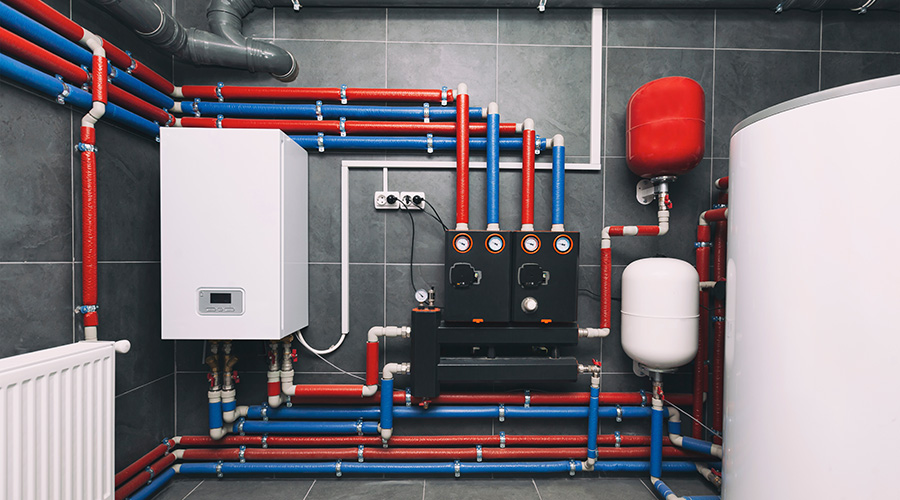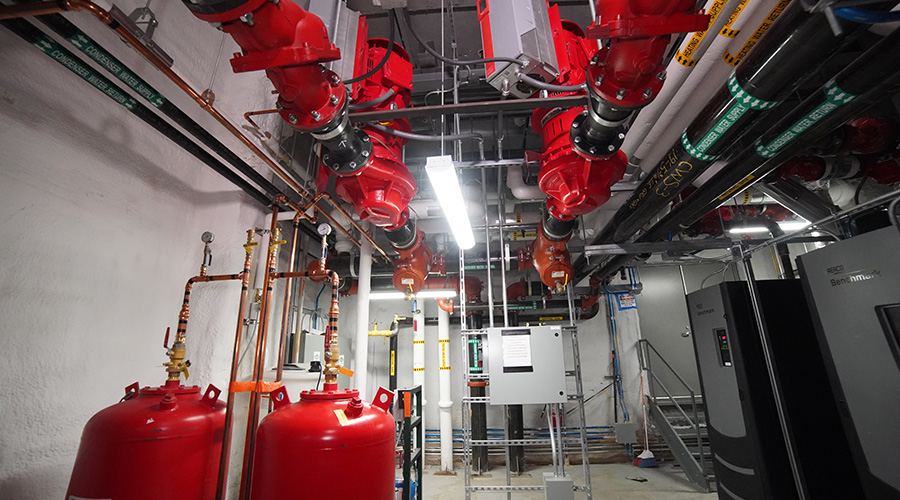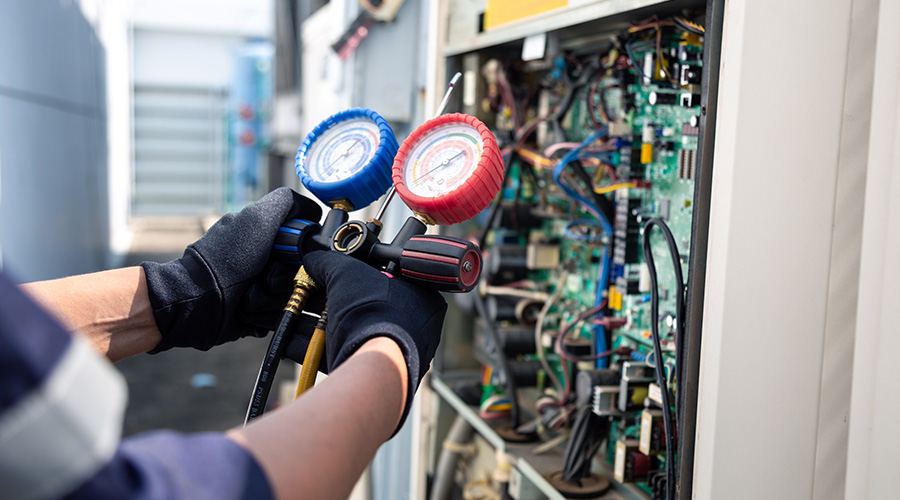Reaping the Benefits of New Chillers
Greater energy efficiency and reduced maintenance are among the potential payoffs for managers who specify the ‘right’ equipment
Facilities have installed a new generation of chillers in recent years that are designed to deliver a range of benefits, including greater energy efficiency, easier monitoring and control, and smaller footprints. These chillers also have created new operating and maintenance requirements.
The challenge for engineering and maintenance managers is determining how these advances affect maintenance procedures and strategies and smoothly incorporating the new requirements into technicians’ existing duties.
Technology Focus
Many recent advances in chiller technology have opened the way for managers to offset some or all of the costs of an upgrade or replacement by significantly lowering operating costs — an important factor in selling the project to facility executives.
For example, magnetic, frictionless bearings eliminate much of the drag and metal-to-metal noise, so they cost less to operate, generate far less noise, and use less power. These bearings eliminate the need for oil coolers, pumps, and piping, and they reduce compressor contamination.
Variable-speed drives (VSDs) and medium-voltage motors for compressors and air handlers provide better integrated ratings for part-load value/non-standard part-load value, which is very important, considering that chillers operate at both design full-load and design entering-water temperature for only about 1 percent of their operating hours. VSDs also require very low starting amps, compared to single-speed drives.
The lower mass of the new chiller designs means greater installation and operation advantages. New, larger-capacity chillers have smaller footprints, often can fit through a 3-foot-wide doorway, and might not require building modifications, unless they add capacity. Even then, the modifications might be minimal compared to the space taken up by older, larger units.
Some new chillers feature refrigerant-storage capability, which eliminates external storage-tank requirements, the need for added space, and refrigerant transfer when maintaining the system.
New digital electronic controls now feature protocol selectability, enabling managers to integrate them more easily with different building automation systems.
As for refrigerants, new formulations are replacing those that are being phased out. Some non-ozone depleting refrigerants, such as HFC 134a, do not have a phaseout date, so selecting this refrigerant or one similar to it eliminates the need to replace it later. Of the most ozone-depleting refrigerants:
-
HCFC-141b production and import stopped in 2003.
-
HCFC-142b and HCFC-22 will stop in 2020.
The production and import of all HCFCs will stop by 2030. Managers making decisions on replacement refrigerant should consider these phaseout dates.
Finally, refrigerant enhancers help sustain the original heat-transfer rate longer, increasing system capacity and reducing energy costs over the chiller’s life.
Impact on Maintenance
Managers will benefit the most from these changes by altering their procedures and strategies to emphasize energy conservation. Substantial benefits include:
-
lower-cost building systems, such as lighting, water and heating
-
smaller cooling loads
-
higher-efficiency cooling systems.
Preapproved energy-efficiency improvement projects also might qualify for federal, local or utility cash incentives for organizations with on-peak demand that reduce their energy-use through energy-saving investments.
One note of caution: The fast and accurate decision making required to takes advantage of these advances and departments’ limited resources requires good operating records and planning. Procedures and strategies developed from such comprehensive documentation work the best.
Incorporating Change
An area where there can be no compromises with excellence is the existence and use of a state-of-the-art work-order and equipment-history record system. Each work order — whether it is for routine, emergency, preventive or upgrade work on equipment or a building space — must describe all of the work performed, labor used, material used, and cost.
The few minutes it takes to record and document this information is worth every penny when evaluating make-or-buy, repair-or-replace options. This is a good place to incorporate the OSHA Process Safety Management rule, particularly the Mechanical Integrity (MI) phase, to ensure that properly documented new procedures, training and change management are in place.
These records and the MI strategy are the basis for the next step: planning. Before managers can make the necessary decision about the next step, they must conduct a thorough and accurate evaluation of present equipment conditions, repair histories, preventive maintenance job plans, and operating costs.
The sequence of events when upgrading, replacing or adding chiller capacity first should include examining the existing system completely, then reducing the load wherever possible, specifying and sizing the chiller accurately for the reduced load, and reviewing new operating and maintenance manuals to select the proper preventive maintenance (PM) tasks and frequencies and scheduling them in the computerized maintenance management system’s PM module.
The good news is that technicians probably can discontinue some tasks. For example, newer chillers might need only periodic control checks, cleaning and tube cleaning to keep them in top shape. Frictionless bearings on new units can eliminate oil system PM. Using a predictive maintenance strategy in scheduling cleaning for heat-exchanger tubes — cleaning them when delta P indicates the need, rather than on a fixed schedule — can minimize the cleaning costs. Using a refrigerant enhancer in a chemical-treatment schedule can substantially reduce heat-transfer loss, which otherwise usually occurs at a rate of 2-5 percent annually without treatment.
Seeing the Big Picture
Making the final decision on bringing in a new chiller requires a thorough analysis, including a review of the building structure, electrical-power distribution and mechanical-piping systems and equipment. Is the building structurally sound? Answering this question is especially important when expanding a cooling load because it might require the reinforcement of mechanical room spaces to handle the higher-capacity equipment.
Technicians also should check the entire electric-power distribution system, including branch and main circuits, starters, wiring, conduit, motors, and switches, and the should thoroughly examine mechanical piping, pumps, air handlers, and valves.
Managers do not want a shut-off valve to fail during installation, causing disruption and a possible system loss. Is the existing cooling tower available for use, or does it require expansion, repair or replacement?
Other elements of the analysis also are important. For example, air-flow imbalance might be drawing in humid outside airthrough cracks or around windows or doors, increasing the cooling load. Sealing and rebalancing this air flow can reduce the load. Also, a dark roof might absorb heat form the sun. Coating its surface with a light, reflective coating can reduce this gain.
Finally, in multi-unit systems, managers should not automatically use the existing dispatch order. Revised loads can mean that a different sequence, determined by computer analysis, is the most cost-effective.
Implementing these approaches offers managers the potential for substantially lower operating cost and more efficient maintenance when it comes to new-generation chillers.
Related Topics:











